
Female athletes have demonstrated the highest risk of ACL injury compared to their male counterparts, with incidence being two to eight times higher than males in soccer, basketball, and volleyball.2,15,18 Increased attention is being paid to prepubescent young athletes secondary to at-risk movement patterns being seen in children as young as 10 years of age as well as increased incidence of injury.11,16–18 Stanitski et al.19 found that ACL injury was associated in 47% of children 7 to 12 years of age who had acute knee effusions.19 Movement patterns play a critical role in ACL injury by creating the potential for anterior tibial shear force, which directly strains the ACL.11,20,21
Both modifiable and nonmodifiable risk factors have been described in the literature. Modifiable risk factors are the premise for ACL prevention programs secondary to the potential to induce change on specific variables. Therefore, this chapter focuses on modifiable risk factors and their role in injury prevention programs.
RISK FACTORS SPECIFIC TO YOUNG ATHLETES
Early Specialization
Preadolescent and adolescent athletes are a special population secondary to the growth and development that occurs as they are trying to meet the demands of sports. Early specialization, maturation, undeveloped physical skills, high-risk movement patterns, and an inadequate strength base are all contributing factors to increased injury rates.11,22 However, children do not master complex motor skills until late childhood (age 10 to 12 years) and demonstrate increased risk of injury when age-appropriate skill set does not meet the demands imposed on them by coaches and sport.11,23 If emphasis is placed on strengthening and the development of fundamental motor skills, as opposed to sports-specific training, then injuries sustained may be reduced.11
Growth Spurts and Maturation
Growth-related factors such as growth spurts, maturity-associated variation, and immature or underdeveloped coordination predispose young athletes to injury.24–26 These factors may exert their influence with more frequent and intensive training and competition seen today.11,21 There have been no differences in incidence in ACL tears reported between preadolescent males and females; however, differences become marked following maturation, with adolescent females demonstrating the most risk.11,28,29 Puberty has been associated with deficits and delays in core stability and neuromuscular regression, and many sex-related differences emerge that have been associated with ACL injury.18–21,27–30
Adolescent female athletes demonstrate measurable neuromuscular imbalances following the onset of maturation. Hewett et al.31 reported that female athletes landed with significantly more medial knee motion and greater maximum lower extremity valgus than male athletes following the onset of maturation. Males appear to have a neuromuscular spurt in strength, power, and coordination during puberty, which allows them to adapt to increased bony lever arms and a greater mass where females show little change (Fig. 14.3A,B).31–33 Core stability declines during growth spurts and may predispose athletes to at-risk movements secondary to mechanical breakdown throughout the kinetic chain.11,22 During growth spurts, there is an increase in bony lever arms and the body’s center of mass changes which impacts postural alignment and neuromuscular control.22 Therefore, core strength, neuromuscular ability, coordination, and proprioception become imbalanced and contribute to risk of injury.21,22,30
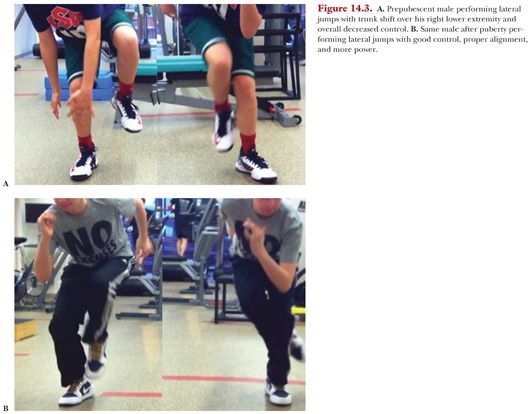
Increased demand for peak performance is expected at younger ages during a time of major physiologic change.10,21 Care should be taken to ensure demands such as expected sports-specific movement patterns or training loads placed on the athlete’s body does not exceed their physiologic capabilities. In addition, a child may master a skill prior to their growth spurt but may need to revisit that skill later on in order to refine the movement patterns secondary to the changes they incur. To successfully reduce the incidence of ACL injuries in young athletes, one must demonstrate an understanding of modifiable risk factors specific to injury prevention programs.
MODIFIABLE RISK FACTORS: COMPONENTS OF ANTERIOR CRUCIATE LIGAMENT PREVENTION PROGRAMS
Many risk factors have been described in the literature. The most effective prevention programs combine a multifaceted approach to address various components. These components include neuromuscular training, plyometric training, resistance training, flexibility, proprioception training, and technique monitoring and feedback. Neuromuscular training has received a lot of attention in the literature secondary to demonstrating the most promise in terms of altering movement patterns and decreasing ACL injuries.14,15 Athletes may display movement patterns, which put them at risk because of one or more imbalances that can be easily addressed with interventions. Hewett et al.29 describe several modifiable risk factors, which have been demonstrated to reduce risk of ACL injury when addressed: ligament dominance, quadriceps dominance, leg dominance, and trunk dominance. Identification of these risk factors allows individuals potentially at risk to be identified and prevention strategies to be provided.
Ligament Dominance
Ligament dominance is defined as the tendency for valgus collapse secondary to neuromuscular imbalances and lack of muscular support about the knee affecting the ability to absorb ground reaction forces29 (Fig. 14.4A,B). Therefore, the static restraints about the knee including bone, cartilage, and ligaments take the increased force.14 An athlete is at high risk when displaying substantial medial knee motion in the coronal plane combined with a low knee flexion angle.34–37 Gluteals, hamstrings, and gastrocnemius-soleus strength are critical components in prevention of ACL injury, and improper recruitment during landing tasks result in high abduction moments with increased strain on the ACL.34–37 In addition, several studies have demonstrated that high school female athletes demonstrate greater maximum knee valgus angle and greater ground reaction forces with a drop vertical jump than males and uninjured athletes, which may explain the higher prevalence of ACL injury in that population.35,36

Female athletes have been shown to exhibit greater hip adduction and internal rotation with decreased knee flexion during tasks such as walking, running, anticipated and unanticipated cutting, and landing.38–40 Increased hip adduction and internal rotation predispose the athlete to valgus collapse at the knee. Gluteus maximus and medius play a role in prevention of dynamic valgus collapse by controlling hip adduction and femoral rotation. Weakness has been associated as a predictor of injury secondary to inability of the weak musculature to keep the hip abducted during high-level single-leg activities such as landing and cutting.38–40 Studies have demonstrated improved control of dynamic valgus collapse of the knee with gluteus maximus and medius strengthening.11,13,38 Several electromyographic studies have reported that side-lying hip abduction, side planks, and lateral band walks elicit sufficient maximal voluntary activation for strengthening of gluteus medius (Fig. 14.5A).41 Side-lying hip abduction may be performed during a side plank if appropriate control and stability can be maintained (Fig. 14.5B). Single-leg squats and single-leg deadlifts have also been demonstrated to maximally elicit gluteus maximus.41
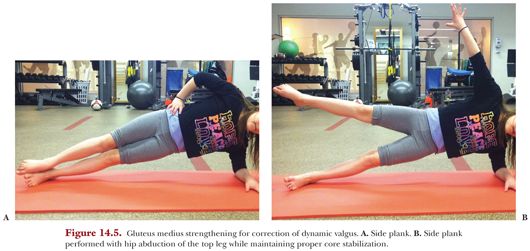
Quadriceps Dominance
Quadriceps dominance occurs during sports maneuvers such as cutting or jumping when preferential activation of knee extensors over flexors occurs.29 The quadriceps acts as an antagonist, exerting maximum strain to the ACL in the last 30 degrees of knee extension.39 In addition, it has been demonstrated that preferential activation of the quadriceps while landing in an erect position exerts anterior shear stress to the knee (Fig. 14.6A–C).28,29,34,37 Hamstring activation has been shown to play a role in controlling dynamic valgus by resisting anterior and lateral tibial translation and rotation.11,27,34,37,39 In addition, hamstring activation with a jump landing or during a cutting maneuver results in a flexed knee posture (Fig. 14.7A–C) and is more protective to the ACL.37,39
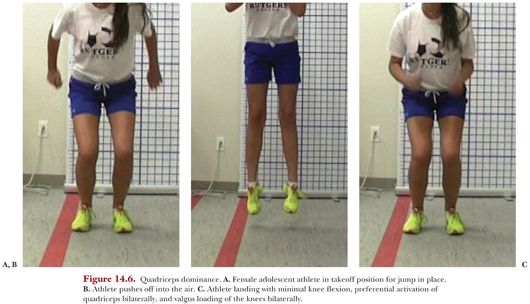
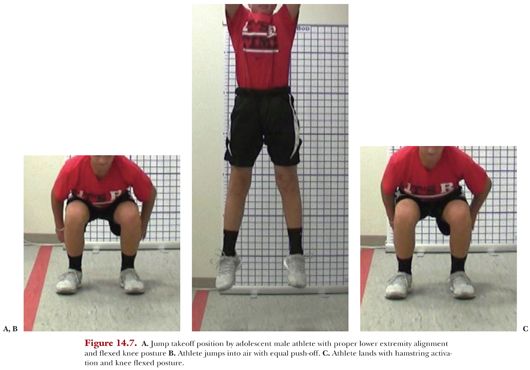
Studies have demonstrated the effectiveness of neuromuscular training with improved dynamic valgus control and decreased strain on the anteromedial bundle of the ACL with prelanding and landing activation.27,32,34,36,40 It has been reported extensively in the literature that females demonstrate a lower hamstring-to-quadriceps ratio, resulting in greater risk of injury.27,29,34,36,37 Ebben et al.37 reported females’ hamstring-to-quadriceps ratio was lower and they sustained quadriceps activation longer during cutting. Other studies have reported that females have the tendency to preferentially activate their quadriceps more than males with jump landings resulting in stiff-legged landings, which do not allow absorption of ground reaction forces.35 Hewett et al.32 demonstrated the effectiveness of a plyometric training program designed to increase hamstring-to-quadriceps torque and a 22% decreased impact force. The studies mentioned highlight the importance of neuromuscular and plyometric training to address hamstring strength and neuromuscular deficits in prevention programs.
Leg Dominance
Leg dominance relates to side-to-side symmetry, balance, and muscular strength, which may place both limbs at risk.29 The weaker limb is compromised in its ability to dissipate forces, whereas the stronger limb is subjected to higher forces secondary to increased dependence and excessive loading (Fig. 14.8A–F).29 Hewett et al.28 reported that females tended to favor one leg more than the other when compared to their male counterparts. Ford et al.35 found that high school female basketball players landed from a vertical jump with significantly greater maximum valgus knee angle on their nondominant side in comparison to their dominant side. In addition, leg dominance may be secondary to asymmetrical muscle weakness and/or pain avoidance. In order to address leg dominance, training should progress from emphasis on quality of double leg movements to single leg movements. For example, if an individual has an asymmetrical squat, they will carry the asymmetry over to their broad jumps. If they do not produce equal force output through each leg, they will then have a difficult time maintaining proper positioning and posture during the jump takeoff and landing. This will reduce performance outcomes as well as increase risk of injury. The weaker leg will have to work harder to maintain an equal position during jumping. Moreover, quality is always more important than quantity. Myers et al.42 discusses the importance of ensuring an athlete does not drop one leg posterior to the other leg during a jump because this facilitates imbalances by overloading the stronger (posterior) leg and unloading the weaker leg. Interventions should focus on ensuring each limb works independently. Some examples of effective exercises are single leg squats, single leg hops, bounding, and single leg balance on unstable surfaces (Fig. 14.9A,B). More complex movement patterns require greater coordination in side-to-side performance and lead to greater balance in side-to-side muscle recruitment as well as ensuring bilateral coordination and power. In order to efficiently correct for leg dominance, the athlete must coordinate multijoint actions and multiplanar movements into power movements that are to be used in competition.42

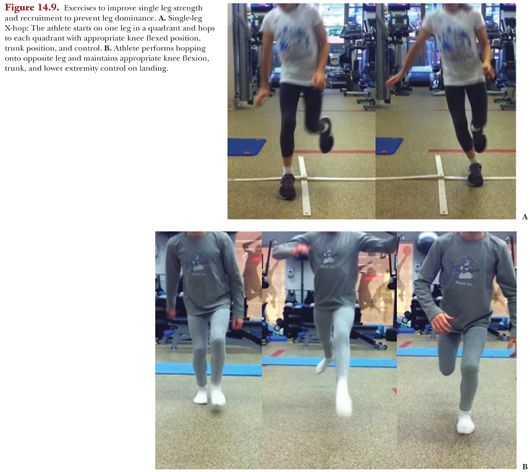
Trunk Dominance
Trunk dominance is caused by increased motion of the body’s center of mass during single-leg landing, pivoting, or deceleration due to decreased core strength and neuromuscular control (Fig. 14.10A,B).11,28,37,40 Athletes without sufficient core strength and trunk control lack the dynamic stability to control excessive trunk motion in the frontal plane. Core deficits and proprioception have been associated with lateral trunk displacement, altered dynamic knee stability, and predicted injury risk.11,13,28,32,40 Young athletes experience growth spurts, which cause changes in bony levers and center of body mass, making muscular control of the trunk more difficult. Therefore, young athletes are more susceptible to injury during growth spurts secondary to imbalanced core strength, neuromuscular control, and coordination deficits that occur during this time.43 Maintaining core strength during growth spurts is vital for young athletes.




